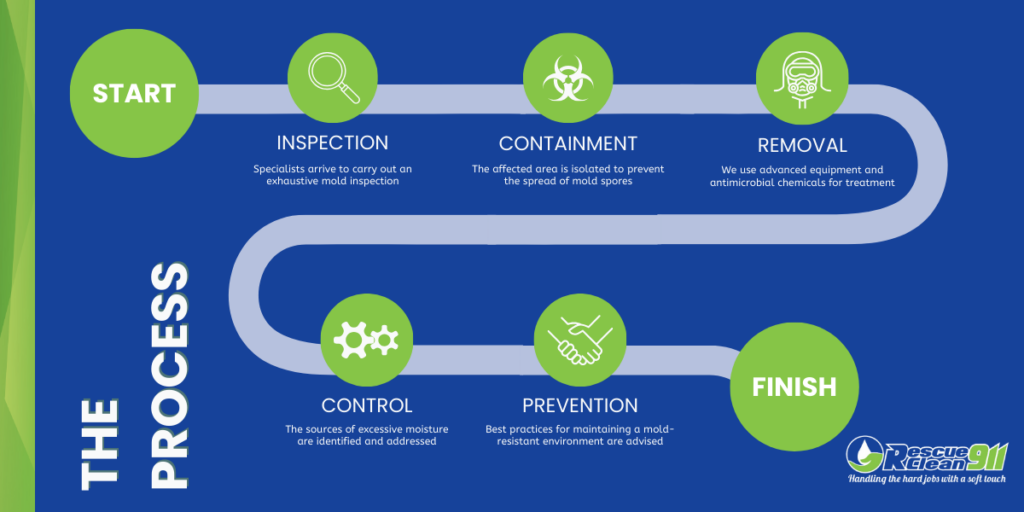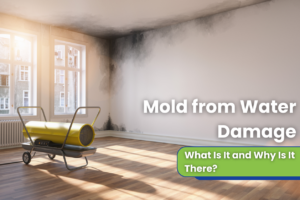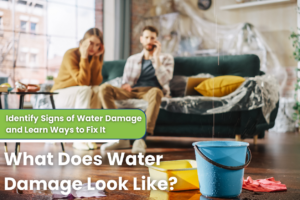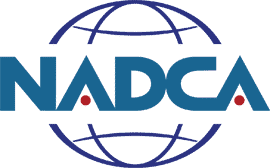How Long Mold Does Remediation Take? Factors, Processes, and More
Jump to:
The response to a mold problem needs to be swift, thorough, and effective. That’s where mold remediation comes in. You may be wondering: “How long does mold remediation take?” This is a question that we hear quite often and the answer is critical for homeowners who want to quickly restore the health and safety of their living environment. Depending on several factors, like size, extent, and potential hazards, it generally takes one to five days.
If you’ve noticed a strange odor in your home or office, or if you or your family members are experiencing unexplained health problems — like respiratory issues or allergic reactions — you might be dealing with an unseen, but all too common foe: mold. Mold growth can be stealthy, creeping in and taking hold under your floors, behind your walls, or above your ceilings, causing problems that extend beyond simple aesthetic damage. It can generate an infestation that is not just nasty, but potentially damages the structural integrity of your property as well. Mold spores can spread quickly and widely, increasing health risks to those exposed, especially for people with compromised immune systems.
Mold remediation is a specialized process designed to not only remove visible mold but also to fix the conditions leading to its growth. Contrary to popular belief, professional mold remediation goes beyond mold removal. It encompasses a thorough approach that treats the affected area(s), removes the contamination, addresses the cause, and also implements preventive measures to inhibit future mold growth.

Factors Affecting the Length of Mold Remediation
When addressing common questions about how long mold remediation takes, it’s important to understand that the duration of the mold remediation process can significantly vary. Generally, you can expect a standard mold remediation process to last anywhere from one to five days. However, this timeframe can change depending on several factors:
- Size and extent of the infestation: The size and depth of the mold infestation directly impacts the length of the remediation process. A small area of mold growth, such as that around a leaky pipe or window, can usually be addressed more quickly than growth across an entire basement or crawl space.
- Type of surfaces affected: Mold tends to favor porous materials like drywall, upholstery, and wood because they provide the organic material molds need to flourish. However, these instances also prove more time-consuming and complicated to deal with, sometimes requiring removal and replacement of the infected materials. On the other hand, non-porous surfaces like tiles or metals can be cleaned in a shorter timeframe.
- Health factors and risks involved: The type of mold present can also influence the timeframe of remediation. Certain types, such as Stachybotrys chartarum or ‘black mold,’ can pose serious health risks. Cleaning such toxic mold demands added caution, elaborate containment setup, and even evacuation of the house occupants, extending the remediation timeline. Primarily, healthcare facilities and homes with individuals suffering from respiratory problems or immune system disorders require careful handling.
Remember, a superior mold remediation process is not rushed. Having a comprehensive approach enables us to provide you with thorough and safe mold remediation services. While it’s reasonable to want a quick resolution, effective mold remediation is a thorough process. Allowing a professional mold remediation company the necessary time can result in a longer lasting solution to your mold issue.
The Process of Mold Remediation
Making itself known by a musty odor, persistent dampness, or visible signs of infestation, mold is a problem that needs to be attended to promptly and professionally. But what does mold remediation entail and how does it differ from mere mold removal? Let’s explore the difference between these two often-confused terms.
Mold remediation aims to control the mold situation, effectively bringing the mold levels back to a natural and safe extent. On the other hand, mold removal is about the total elimination of mold, which isn’t necessarily possible because we share an environment. Professional mold remediation focuses on restoring a healthy environment rather than chasing an unrealistic ‘mold-free’ state.
Step 1: Inspection
The process of mold remediation typically starts with an initial inspection. Mold specialists arrive at your property and carry out an exhaustive mold inspection to assess the severity and extent of visible mold and potential hidden mold growth. This visual assessment, often supplemented by moisture meters and infrared cameras, identifies the problem area(s) and helps formulates an action plan tailored to your specific needs.
Step 2: Containment
Once the extent of the problem is defined, we will begin the containment phase. The affected area is securely isolated using plastic sheeting and advanced techniques to prevent the spread of mold spores. Our mold remediation professionals wear protective gear including gloves, goggles, and respirators given the potential health risks associated with mold exposure.
Step 3: Removal
Following containment comes probably the most vital phase – the actual mold removal. The moldy area is subjected to a thorough cleaning process, using advanced equipment and EPA-approved antimicrobial chemicals. Non-porous materials can often be cleaned and salvaged, but porous materials like drywall and carpeting are usually removed and disposed of. It’s important to note that remediation isn’t a ‘one size fits all’ solution, as the method can vary depending on the type of mold and the extent of contamination.
Step 4: Moisture Control and Prevention
Moisture control is a critical step since mold thrives in moist conditions. High humidity levels in your home or office can increase mold growth. An essential part of mold remediation is identifying and addressing the sources of extra moisture, such as a leaky pipe or inadequate ventilation, ensuring that relative humidity inside is kept under control. After the source is found, preventive measures are put in place. Comprehensive mold remediation includes strategies to avoid a repeat occurrence, ranging from fixing moisture issues to advising on best practices for maintaining a mold-resistant environment.
Mold remediation extends beyond simple mold removal to a thorough and thoughtful process that aims to fully restore healthy living conditions.

FAQs on Mold Remediation
Addressing the concerns and queries of our clients is a priority at RescueClean 911. Here are some answers to frequently asked questions about mold remediation:
How do I know if I have mold?
Common signs of mold include a musty odor, visible mold growth on walls or ceilings, discoloration of surfaces, and persistent health issues like respiratory problems or allergic reactions. Remember, even if you can’t see mold, a musty smell is a good indicator of its presence. A professional mold inspection can help confirm and assess the extent of a mold issue.
Can I do mold remediation myself?
While minor mold problems can be addressed with over-the-counter mold removal products, like Ammonia, larger infestations or toxic mold varieties need the expertise of professional mold remediation specialists. The process often requires specialized equipment, experience, and protective gear. Attempting to do it yourself may cause spores to spread, worsening the problem and posing health risks.
What is the cost of professional mold remediation?
The cost of mold remediation isn’t ‘one-size-fits-all’. It varies based on square footage or the amount of mold, type of mold, and if there’s structural damage that needs repair. In general, mold remediation costs may vary greatly, but your insurance company may cover some or all costs involved, depending on your policy’s terms.
Is it safe to stay in the house during mold remediation?
The answer depends on the extent of mold growth, the area of your house affected, and the kind of mold present. For substantial infestations or when toxic mold like black mold is involved, it’s often recommended that residents temporarily vacate the premises for their safety.
How can one prevent mold growth after remediation?
Preventive measures include controlling humidity levels, addressing leaks promptly, and ensuring proper ventilation. Regular inspections can also help detect and address a mold problem before it turns into a severe infestation.
We’re Here When You Need Us
Mold can be a silent intruder, wreaking havoc subtly and persistently. It’s a stressor, a health hazard, and a property destroyer. Prompt and professional action is critical when you encounter a mold problem in your home or office. Understanding the issue and dealing with it correctly has significant implications not only for the structural integrity of your property but also for the health of its occupants.
At RescueClean 911, we understand the urgency and meticulousness required for effective mold remediation. Our specialists employ a systematic and targeted approach, balancing thoroughness with efficiency. We strive to complete the remediation process within the quickest possible time, without compromising on comprehensiveness or quality.
While the timescales may vary, the service quality and commitment you receive from our expert team remain constant. As a leading mold remediation company in South Florida, we are dedicated to restoring your property to a safe, pre-loss condition and committing to preventive measures to minimize the risk of future mold growth.
Remember, the key to effective mold remediation lies not in the speed, but in the skill, proficiency, and extensive knowledge that RescueClean 911 brings to the table. Get in touch with us today for thorough, professional mold remediation that you can trust.










